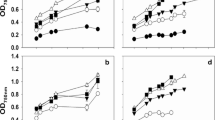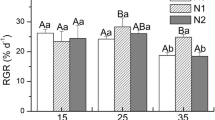Abstract
Silicon deficiency is a lipid-promoting stress for many oleaginous diatoms. Literature reports suggest that reduced salinity in seawater, a primary component of which is sodium chloride, may inhibit metabolism of silicon in marine diatoms. We hypothesized that lowering sodium chloride below ocean levels may thus be effective in creating silicon stress and enhancing lipid productivity. We examined the interacting effects of silicon supply (0.05, 0.1, 0.2, and 0.8 mM) and sodium chloride concentration (50, 100, and 400 mM) on growth and lipid production in Chaetoceros gracilis. This was done in batch culture to facilitate the application of severe stress. Low levels of either sodium chloride or silicon resulted in at least 50 % increases in lipid content. The synergy of simultaneous, moderate sodium chloride and silicon stress resulted in lipid content up to 73 % of dry mass and lipid productivity of 1.7 g m−2 day−1; with a daily integrated photosynthetic photon flux of 17.3 mol photons m−2 day−1, the efficiency of lipid synthesis was thus 0.1 g mol−1 of photons. Decreased silicon also resulted in a 5 % shift in lipid chain length from C18 to C16 fatty acids. We observed a strong sodium chloride/silicon interaction on total and ash-free dry mass densities that arose because low sodium chloride concentrations were inhibitory to growth, but the inhibition was overcome with excessive silicon supply. This observation suggests that low levels of sodium chloride may have affected metabolism of silicon. The findings of this study can be used to enhance lipid production in oleaginous marine diatoms.




Similar content being viewed by others
References
Adams C, Godfrey V, Wahlen B, Seefeldt L, Bugbee B (2013) Understanding precision nitrogen stress to optimize the growth and lipid content tradeoff in oleaginous green microalgae. Bioresour Technol 131:188–194
Araujo GS, Matos LJBL, Goncalves LRB, Fernandes FAN, Farias WRL (2011) Bioprospecting for oil producing microalgal strains: evaluation of oil and biomass production for ten microalgal strains. Bioresour Technol 102:5248–5250
Bhattacharyya P, Volcani BE (1980) Sodium-dependent silicate transport in the apochlorotic marine diatom Nitzschia alba. Proc Natl Acad Sci Biol 77:6386–6390
Bugbee B, Monje O (1992) The limits of crop productivity. Bioscience 42:494–502
Chelf P (1990) Environmental control of lipid and biomass production in two diatom species. J Appl Phycol 2:121–129
Enright CT, Newkirk GF, Craigie JS, Castell JD (1986) Growth of juvenile Ostrea-edulis L fed Chaetoceros gracilis Schütt of varied chemical composition. J Exp Mar Biol Ecol 96:15–26
Hem JD (1985) Study and interpretation of the chemical characteristics of natural waters, 3rd edn. United States Government Printing Office, Alexandria
Hildebrand M, Volcani BE, Gassmann W, Schroeder JI (1997) A gene family of silicon transporters. Nature 385:688–689
Hildebrand M, Davis AK, Smith SR, Traller JC, Abbriano R (2012) The place of diatoms in the biofuels industry. Future Sci 3:221–240
Lombardi AT, Wangersky PJ (1991) Influence of phosphorus and silicon on lipid class production by the marine diatom Chaetoceros gracilis grown in turbidostat cage cultures. Mar Ecol Prog Ser 77:39–47
Martin-Jezequel V, Hildebrand M, Brzezinski MA (2000) Silicon metabolism in diatoms: implications for growth. J Phycol 36:821–840
McGinnis KM, Dempster TA, Sommerfeld MR (1997) Characterization of the growth and lipid content of the diatom Chaetoceros muelleri. J Appl Phycol 9:19–24
Merchant SS, Kropat J, Liu BS, Shaw J, Warakanont J (2012) TAG, you're it! Chlamydomonas as a reference organism for understanding algal triacylglycerol accumulation. Curr Opin Biotechnol 23:352–363
Mortensen SH, Børsheim KY, Rainuzzo JR, Knutsen G (1988) Fatty acid and elemental composition of the marine diatom Chaetoceros gracilis Schütt. Effects of silicate deprivation, temperature and light intensity. J Exp Mar Biol Ecol 122:173–185
Parrish CC, Wangersky PJ (1990) Growth and lipid class composition of the marine diatom, Chaetoceros gracilis, in laboratory and mass-culture turbidostats. J Plankton Res 12:1011–1021
Shifrin NS, Chisholm SW (1981) Phytoplankton lipids: interspecific differences and effects of nitrate, silicate and light–dark cycles. J Phycol 17:374–384
Sumper M, Brunner E (2008) Silica biomineralisation in diatoms: the model organism Thalassiosira pseudonana. Chembiochem 9:1187–1194
Sumper M, Kroger N (2004) Silica formation in diatoms: the function of long-chain polyamines and silaffins. J Mater Chem 14:2059–2065
Taguchi S, Hirata JA, Laws EA (1987) Silicate deficiency and lipid-synthesis of marine diatoms. J Phycol 23:260–267
Thamatrakoln K, Hildebrand M (2008) Silicon uptake in diatoms revisited: a model for saturable and nonsaturable uptake kinetics and the role of silicon transporters. Plant Physiol 146:1397–1407
Traller JC, Hildebrand M (2013) High throughput imaging to the diatom Cyclotella cryptica demonstrates substantial cell-to-cell variability in the rate and extent of triacylglycerol accumulation. Algal Res 2:244–252
Tuchman ML, Theriot E, Stoermer EF (1984) Effects of low-level salinity concentrations on the growth of Cyclotella meneghiniana Kütz (Bacillariophyta). Arch Protistenkd 128:319–326
Vrieling EG, Poort L, Beelen TPM, Gieskes WWC (1999) Growth and silica content of the diatoms Thalassiosira weissflogii and Navicula salinarum at different salinities and enrichments with aluminium. Eur J Phycol 34:307–316
Vrieling EG, Sun QY, Tian M, Kooyman PJ, Gieskes WWC, van Santen RA, Sommerdijk NAJM (2007) Salinity-dependent diatom biosilicification implies an important role of external ionic strength. Proc Natl Acad Sci U S A 104:10441–10446
Wahlen BD, Willis RM, Seefeldt LC (2011) Biodiesel production by simultaneous extraction and conversion of total lipids from microalgae, cyanobacteria, and wild mixed-cultures. Bioresour Technol 102:2724–2730
Acknowledgments
We would like to thank Cade Adams, a research technician who did great work on these experiments. We also thank Xin Dai of the Utah Agricultural Experiment Station for statistical support. This research was funded by the US Department of Energy through the BioEnergy Center at Utah State University. This research was also supported by the Utah Agricultural Experiment Station, Utah State University and approved as journal paper number 8532.
Author information
Authors and Affiliations
Corresponding author
Rights and permissions
About this article
Cite this article
Adams, C., Bugbee, B. Enhancing lipid production of the marine diatom Chaetoceros gracilis: synergistic interactions of sodium chloride and silicon. J Appl Phycol 26, 1351–1357 (2014). https://doi.org/10.1007/s10811-013-0156-7
Received:
Revised:
Accepted:
Published:
Issue Date:
DOI: https://doi.org/10.1007/s10811-013-0156-7




